Modeling Diameter Distribution of Black Alder (Alnus glutinosa (L.) Gaertn.) Stands in Poland
Abstract
1. Introduction
2. Materials and Methods
2.1. Data Collection
2.2. Diameter Distribution Models
2.3. Model Evaluation and Validation
3. Results
3.1. Parametrization of the Diameter Distribution Models
3.2. Evaluation and Comparison of the Distribution Models
4. Discussion
5. Conclusions
Author Contributions
Funding
Acknowledgments
Conflicts of Interest
References
- Claessens, H.; Oosterbaan, A.; Rondeux, J.; Savill, P. A review of the characteristics of black alder (Alnus glutinosa (L.) Gaertn.) and their implications for silvicultural practices. Forestry 2010, 83, 163–175. [Google Scholar] [CrossRef]
- Kajba, D.; Gračan, J. EUFORGEN Technical Guidelines for Genetic Conservation and Use for Black Alder (Alnus glutinosa); International Plant Genetic Resources Institute: Rome, Italy, 2003; p. 4. [Google Scholar]
- Pancer-Kotejowa, E.; Zarzycki, K. Zarys ekologii. In Nasze Drzewa Leśne Olsze; PWN: Warszawa-Poznań, Polska, 1980; pp. 229–249. [Google Scholar]
- Główny Urząd Statystyczny. Leśnictwo. In Rocznik Statystyczny Rzeczypospolitej Polskiej; Rozkrut, D., Ed.; Zakład Wydawnictw Statystycznych: Warszawa, Polska, 2018; pp. 493–497. [Google Scholar]
- Pietrzykowski, M.; Woś, B.; Chodak, M.; Sroka, K.; Pająk, M.; Wanic, T.; Krzaklewski, W. Effects of alders (Alnus sp.) used for reclamation of lignite combustion wastes. J. Am. Soc. Min. Reclam. 2018, 7, 30–55. [Google Scholar] [CrossRef]
- Sroka, K.; Chodak, M.; Klimek, B.; Pietrzykowski, M. Effect of black alder (Alnus glutinosa) admixture to Scots pine (Pinus sylvestris) plantations on chemical and microbial properties of sandy mine soils. Appl. Soil Ecol. 2018, 124, 62–68. [Google Scholar] [CrossRef]
- Liu, C.; Zhang, S.Y.; Lei, Y.; Newton, P.F.; Zhang, L. Evaluation of three methods for predicting diameter distributions of black spruce (Picea mariana) plantations in central Canada. Can. J. For. Res. 2004, 34, 2424–2432. [Google Scholar] [CrossRef]
- Bailey, R.L.; Dell, T.R. Quantifying diameter distribution with the Weibull function. For. Sci. 1973, 19, 97–104. [Google Scholar]
- Kangas, A.; Maltamo, M. Calibrating predicted diameter distribution with additional information. For. Sci. 2000, 46, 390–396. [Google Scholar]
- Maltamo, M.; Kangas, A.; Uuttera, J.; Torniainen, T.; Saramäki, J. Comparison of percentile based prediction methods and the Weibull distribution in describing the diameter distribution of heterogeneous Scots pine stands. For. Ecol. Manag. 2000, 133, 263–274. [Google Scholar] [CrossRef]
- Calzado Carretero, A.; Torres Alvarez, E. Modelling diameter distributions of Quercus suber L. stands in “Los Alcornocales” Natural Park (Cádiz-Málaga, Spain) by using the two parameter Weibull functions. For. Syst. 2013, 22, 15–24. [Google Scholar] [CrossRef]
- de Lima, R.A.F.; Batista, J.L.F.; Prado, P.I. Modeling tree diameter distributions in natural forests: An evaluation of 10 statistical models. For. Sci. 2015, 61, 320–327. [Google Scholar] [CrossRef]
- Gove, J.H.; Patil, G.P. Modeling the basal area-size distribution of forest stands: A compatible approach. For. Sci. 1998, 44, 285–297. [Google Scholar]
- Mehtätalo, L. An algorithm for ensuring compatibility between estimated percentiles of diameter distribution and measured stand variables. For. Sci. 2004, 50, 20–32. [Google Scholar]
- Maltamo, M.; Mehtätalo, L.; Valbuena, R.; Vauhkonen, J.; Packalen, P. Airborne laser scanning for tree diameter distribution modelling: A comparison of different modelling alternatives in a tropical single-species plantation. Forestry 2018, 91, 121–131. [Google Scholar] [CrossRef]
- Palahí, M.; Pukkala, T.; Blasco, E.; Trasobares, A. Comparison of beta, Johnson’s SB, Weibull and truncated Weibull functions for modeling the diameter distribution of forest stands in Catalonia (north-east of Spain). Eur J. For. Res. 2007, 126, 563–571. [Google Scholar] [CrossRef]
- Nord-Larsen, T.; Cao, Q.V. A diameter distribution model for even-aged beech in Denmark. For. Ecol. Manag. 2006, 231, 218–225. [Google Scholar] [CrossRef]
- Maltamo, M.; Puumalainen, J.; Päivinen, R. Comparison of beta and Weibull functions for modelling basal area diameter distribution in stands of Pinus sylvestris and Picea abies. Scand. J. For. Res. 1995, 10, 284–295. [Google Scholar] [CrossRef]
- Zhang, X.; Lei, Y. A linkage among whole-stand model, individual-tree model and diameter-distribution model. J. For. Sci. 2010, 56, 600–608. [Google Scholar] [CrossRef]
- Ochał, W.; Pająk, M.; Pietrzykowski, M. Struktura grubości wybranych drzewostanów sosnowych wzrastających na zrekultywowanych dla leśnictwa obiektach pogórniczych. [Diameter structure of selected pine stands growing on post-mining sites reclaimed for forestry]. Sylwan 2010, 154, 323–332. [Google Scholar]
- Orzeł, S.; Pogoda, P.; Ochał, W. Ocena przydatności wybranych funkcji do modelowania rozkładu pierśnic w drzewostanach olszy czarnej (Alnus glutinosa (L.) Gaertn.). [Evaluation of usefulness of selected functions for modeling distribution of breast height diameter in black alder stands (Alnus glutinosa (L.) Gaertn.)]. Sylwan 2017, 161, 101–113. [Google Scholar]
- Zasada, M. Evaluation of the double normal distribution for tree diameter distribution modeling. Silva. Fenn. 2013, 47, 1–17. [Google Scholar] [CrossRef]
- Ek, A.R.; Issos, J.N.; Bailey, R.L. Solving for Weibull diameter distribution parameters to obtain specified mean diameters. For. Sci. 1975, 21, 290–292. [Google Scholar]
- Shiver, B.D. Sample sizes and estimation methods for the Weibull distribution for unthinned slash pine plantation diameter distributions. For. Sci. 1988, 34, 809–814. [Google Scholar]
- Kilkki, P.; Maltamo, M.; Mykkänen, R.; Päivinen, R. Use of the Weibull function in estimating the basal area dbh-distribution. Silva. Fenn. 1989, 23, 311–318. [Google Scholar] [CrossRef]
- Borders, B.E.; Patterson, W.D. Projecting stand tables: A comparison of the Weibull diameter distribution method, a percentile-based projection method, and a basal area growth projection method. For. Sci. 1990, 36, 413–424. [Google Scholar]
- Knowe, S.A.; Ahrens, G.R.; DeBell, D.S. Comparison of diameter-distribution-prediction, stand-table-projection and individual-tree-growth modelling approaches for young red alder plantations. For. Ecol. Manag. 1997, 98, 49–60. [Google Scholar] [CrossRef]
- Cao, Q.V. Predicting parameters of a Weibull function for modeling diameter distribution. For. Sci. 2004, 50, 682–685. [Google Scholar]
- Newton, P.F.; Lei, Y.; Zhang, S.Y. A parameter recovery model for estimating black spruce diameter distributions within the context of a stand density management diagram. For. Chron. 2004, 80, 349–358. [Google Scholar] [CrossRef][Green Version]
- Ercanli, I.; Bolat, F.; Kahriman, A. Comparing Parameter Recovery Methods for Diameter Distribution Models of Oriental Spruce (Picea orientalis (L.) Link.) and Scotch Pine (Pinus sylvestris L.) mixed stands located Trabzon and Giresun Forest Regional Directorate; Oral presentation. International Caucasian Forestry Symposium: Artvin, Turkey, 24–26 October 2013. [Google Scholar]
- Siipilehto, J.; Mehtätalo, L. Parameter recovery vs. parameter prediction for the Weibull distribution validated for Scots pine stands in Finland. Silva. Fenn. 2013, 47. [Google Scholar] [CrossRef]
- Mønness, E. Diameter Distributions and Height Curves in Even-Aged Stands of Pinus sylvestris L; Reports of the Norwegian Forest Research Institute: Ås, Norway, 1982; Volume 36, pp. 1–40. [Google Scholar]
- Fonseca, T.F.; Marques, C.P.; Parresol, B.R. Describing Maritime Pine diameter distribution with Johnson’s SB distribution using a new all-parameter recovery approach. For. Sci. 2009, 55, 367–373. [Google Scholar]
- Mateus, A.; Tomé, M. Modelling the diameter distribution of eucalyptus plantations with Johnson’s SB probability density function: Parameters recovery from a compatible system of equations to predict stand variables. Ann. For. Sci. 2011, 68, 325–335. [Google Scholar] [CrossRef][Green Version]
- Siipilehto, J. Methods and Applications for Improving Parameter Prediction Models for Stand Structures in Finland. Ph.D Thesis, University of Helsinki, Helsinki, Finland, September 2011; p. 56. [Google Scholar]
- Reynolds, M.R.; Burk, T.E.; Huang, W.C. Goodness-of-fit tests and model selection procedures for diameter distribution models. For. Sci. 1988, 34, 373–399. [Google Scholar]
- Hyink, D.M.; Moser, J.W., Jr. A generalized framework for projecting forest yield and stand structure using diameter distributions. For. Sci. 1983, 29, 85–95. [Google Scholar]
- Borders, B.E.; Souter, R.A.; Bailey, R.L.; Ware, K.D. Percentile-based distributions characterize forest stand tables. For. Sci. 1987, 33, 570–576. [Google Scholar]
- Siipilehto, J. Improving the accuracy of predicted basal-area diameter distribution in advanced stands by determining stem number. Silva. Fenn. 1999, 33, 281–301. [Google Scholar] [CrossRef]
- Kangas, A.; Maltamo, M. Percentile based basal area diameter distribution models for Scots Pine, Norway Spruce and Birch Species. Silva. Fenn. 2000, 34, 371–380. [Google Scholar] [CrossRef]
- Kangas, A.; Maltamo, M. Performance of percentile based diameter distribution prediction and Weibull method in independent data sets. Silva. Fenn. 2000, 34, 381–398. [Google Scholar] [CrossRef]
- Stankova, T.; Diéguez-Aranda, U. Diameter distribution model for Scots Pine plantations in Bulgaria. For. Ideas 2010, 16, 155–162. [Google Scholar]
- Stankova, T.V.; Zlatanov, T.M. Modeling diameter distribution of Austrian black pine (Pinus nigra Arn.) plantations: A comparison of the Weibull frequency distribution function and percentile-based projection methods. Eur J. For. Res. 2010, 129, 1169–1179. [Google Scholar] [CrossRef]
- Socha, J.; Ochał, W. Dynamic site index model and trends in changes of site productivity for Alnus glutinosa (L.) Gaertn. in southern Poland. Dendrobiology 2017, 77, 45–57. [Google Scholar] [CrossRef]
- Pandey, R.; Dhall, S.P.; Kumar, R. Cross-validation–a tool for forest modelers. Indian For. 1999, 125, 1224–1227. [Google Scholar]
- Refaeilzadeh, P.; Tang, L.; Liu, H. Cross-Validation. In Encyclopedia of Database Systems; Liu, L., Özsu, M.T., Eds.; Springer: Boston, MA, USA, 2009; p. 6. [Google Scholar]
- Arlot, S.; Celisse, A. A survey of cross-validation procedures for model selection. Stat. Surv. 2010, 4, 40–79. [Google Scholar] [CrossRef]
- Merganič, J.; Sterba, H. Characterisation of diameter distribution using the Weibull function: Method of moments. Eur J. For. Res. 2006, 125, 427–439. [Google Scholar] [CrossRef]
- Al-Fawzan, M. Methods for Estimating the Parameters of Weibull Distribution; King Abdulaziz City for Science and Technology: Riyadh, Saudi Arabia, 2000. [Google Scholar]
- Nanang, D. Suitability of the Normal, Log-normal and Weibull distributions for fitting diameter distributions of neem plantations in Northern Ghana. For. Ecol. Manag. 1998, 103, 1–7. [Google Scholar] [CrossRef]
- Zhang, L.; Packard, K.C.; Liu, C. A comparison of estimation methods for fitting Weibull and Johnson’s SB distributions to mixed spruce-fir stands in northeastern North America. Can. J. For. Res. 2003, 33, 1340–1347. [Google Scholar] [CrossRef]
- R Core Team. R: A Language and Environment for Statistical Computing; R Foundation for Statistical Computing: Vienna, Austria, 2018. [Google Scholar]
- Kuhn, M.; Wing, J.; Weston, S.; Williams, A.; Keefer, C.; Engelhardt, A.; Cooper, T.; Mayer, Z.; Kenkel, B.; Benesty, M.; et al. Caret: Classification and Regression Training. R package version 6.0-81. Available online: https://CRAN.R-project.org/package=caret (accessed on 10 February 2019).
- Henningsen, A.; Hamann, J.D. Systemfit: A Package for Estimating Systems of Simultaneous Equations in R. J. Stat. Softw. 2007, 23, 1–40. [Google Scholar] [CrossRef]
- Orzeł, S.; Pogoda, P.; Ochał, W. Stała krzywa wysokości dla olszy czarnej (Alnus glutinosa (L.) Gaertn.) z zachodniej części Kotliny Sandomierskiej. [Generalized height-diameter model for black alder (Alnus glutinosa (L.) Gaertn.) in the western part of the Sandomierz Basin]. Sylwan 2014, 158, 840–849. [Google Scholar]
- Curtis, R.O.; Marshall, D.D. Why quadratic mean diameter? West. J. Appl. For. 2000, 15, 137–139. [Google Scholar]
- Lei, Y. Evaluation of three methods for estimating the Weibull distribution parameters of Chinese pine (Pinus tabulaeformis). J. For. Sci. 2008, 54, 566–571. [Google Scholar] [CrossRef]
- Gorgoso, J.J.; Rojo, A.; Camara-Obregon, A.; Dieguez-Aranda, U. A comparison of estimation methods for fitting Weibull, Johnson’s SB and beta functions to Pinus pinaster, Pinus radiata and Pinus sylvestris stands in northwest Spain. For. Syst. 2012, 21, 446–459. [Google Scholar] [CrossRef]
- Poudel, K.P.; Cao, Q.V. Evaluation of methods to predict Weibull parameters for characterizing diameter distributions. For. Sci. 2013, 59, 243–252. [Google Scholar] [CrossRef]
- Bullock, B.P.; Burkhart, H.E. Juvenile diameter distributions of loblolly pine characterized by the two-parameter Weibull function. New For. 2005, 29, 233–244. [Google Scholar] [CrossRef]
- Von Gadow, K.; Zhang, C.Y.; Wehenkel, C.; Pommerening, A.; Corral-Rivas, J.; Korol, M.; Myklush, S.; Hui, G.Y.; Kiviste, A.; Zhao, X.H. Forest structure and diversity. In Continuous Cover Forestry; Pukkala, T., Von Gadow, K., Eds.; Springer: Dordrecht, The Netherlands, 2012; pp. 29–83. [Google Scholar]
- García, O. What is a diameter distribution? In Proceedings of the Symposium on Integrated Forest Management Information Systems, Tsukuba, Japan, 13–18 October 1991; Minowa, M., Tsuyuki, S., Eds.; Japan Society of Forest Planning Press: Tsukuba, Japan, 1992; pp. 11–29. [Google Scholar]
- Goelz, J.C.G. Forest growth and yield models viewed from different perspective. Math. Modeling Sci. Comput. 2002, 13, 177–189. [Google Scholar]
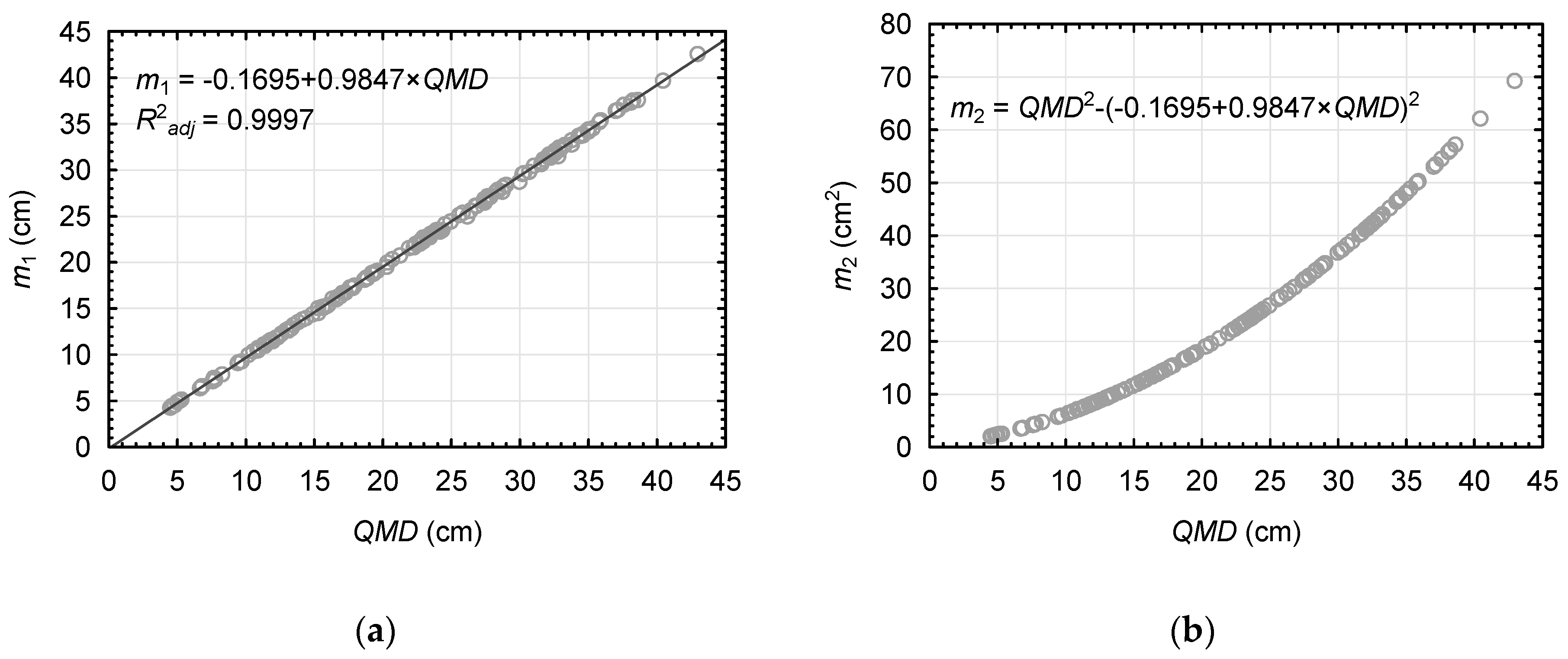
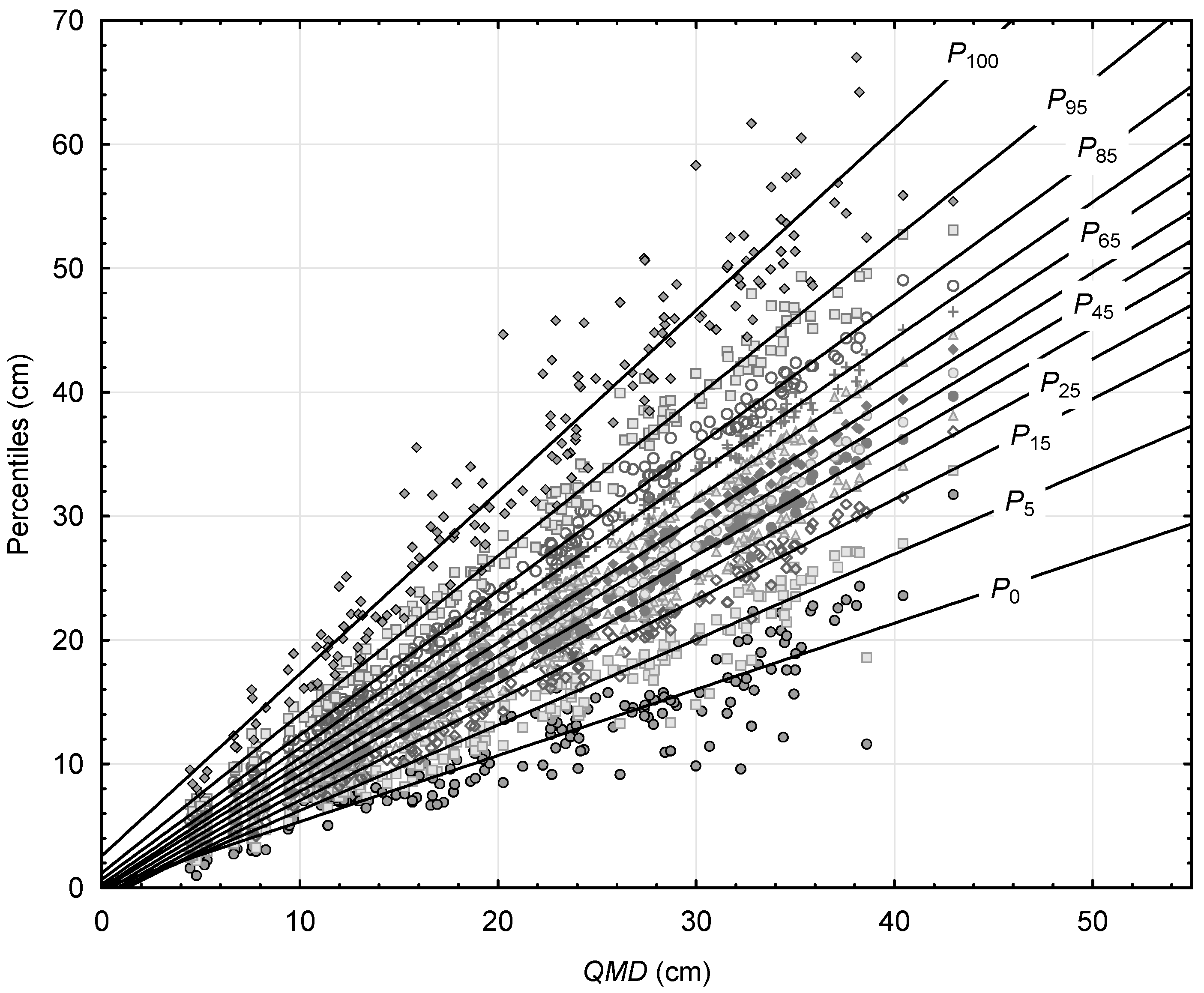
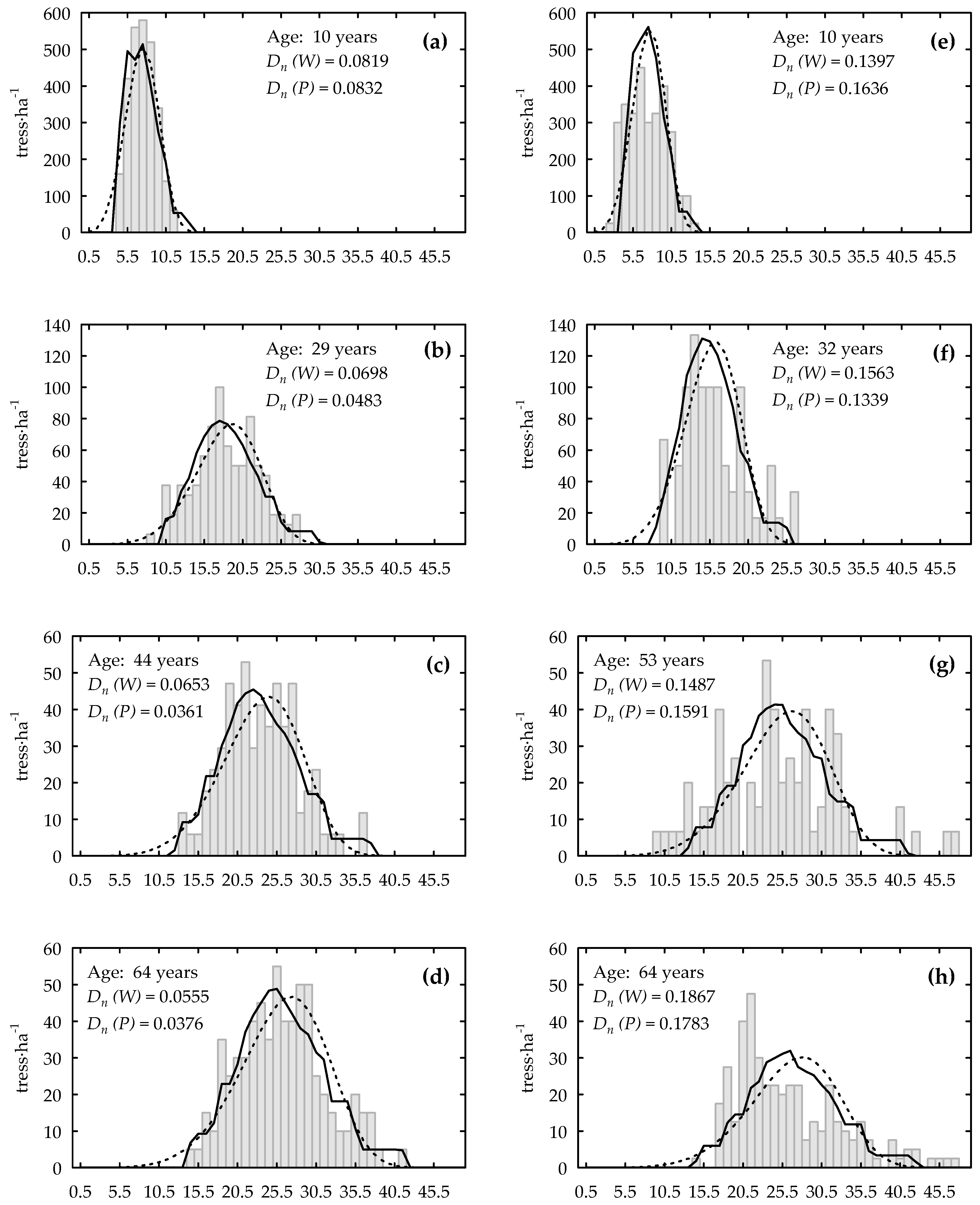
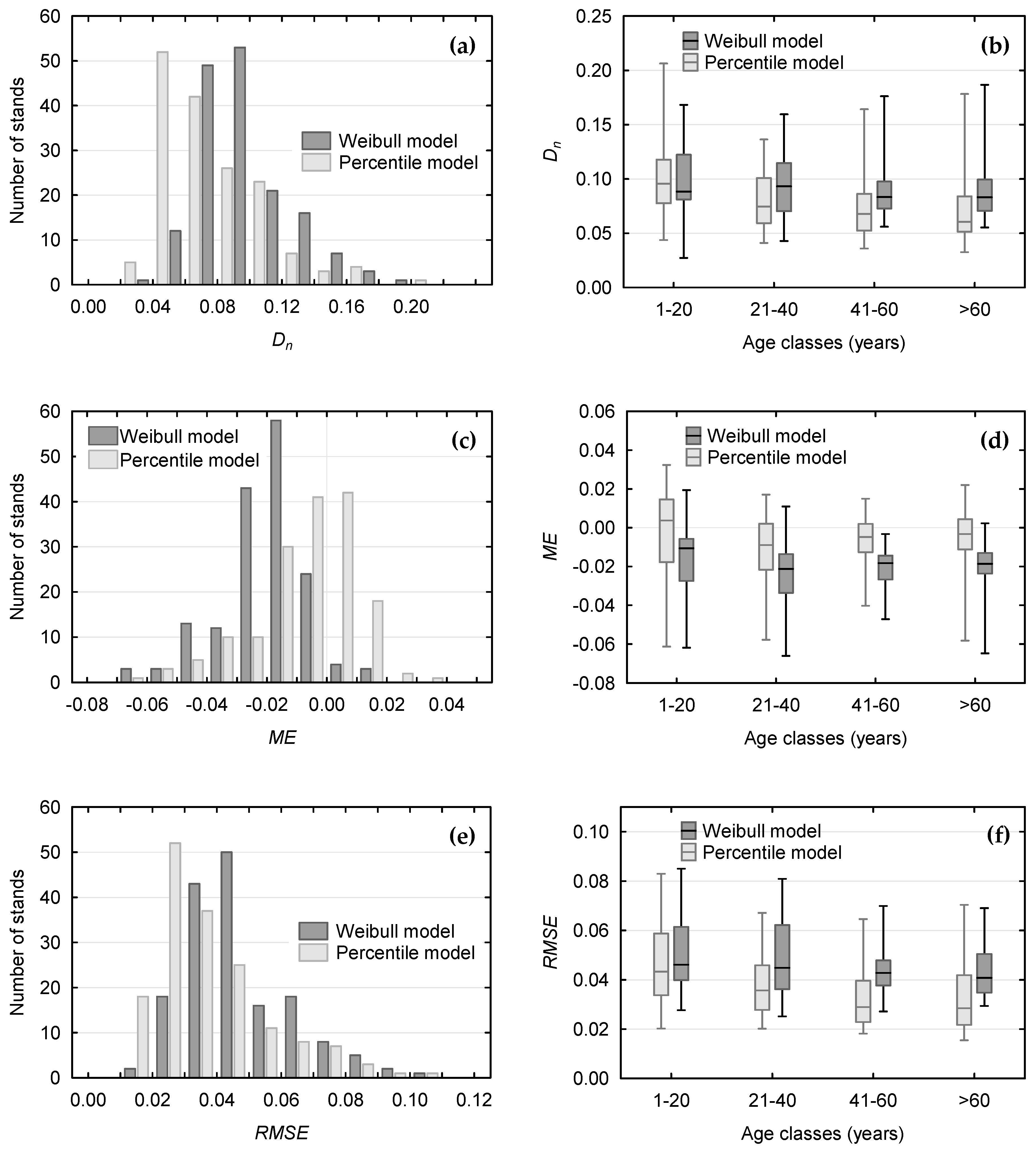
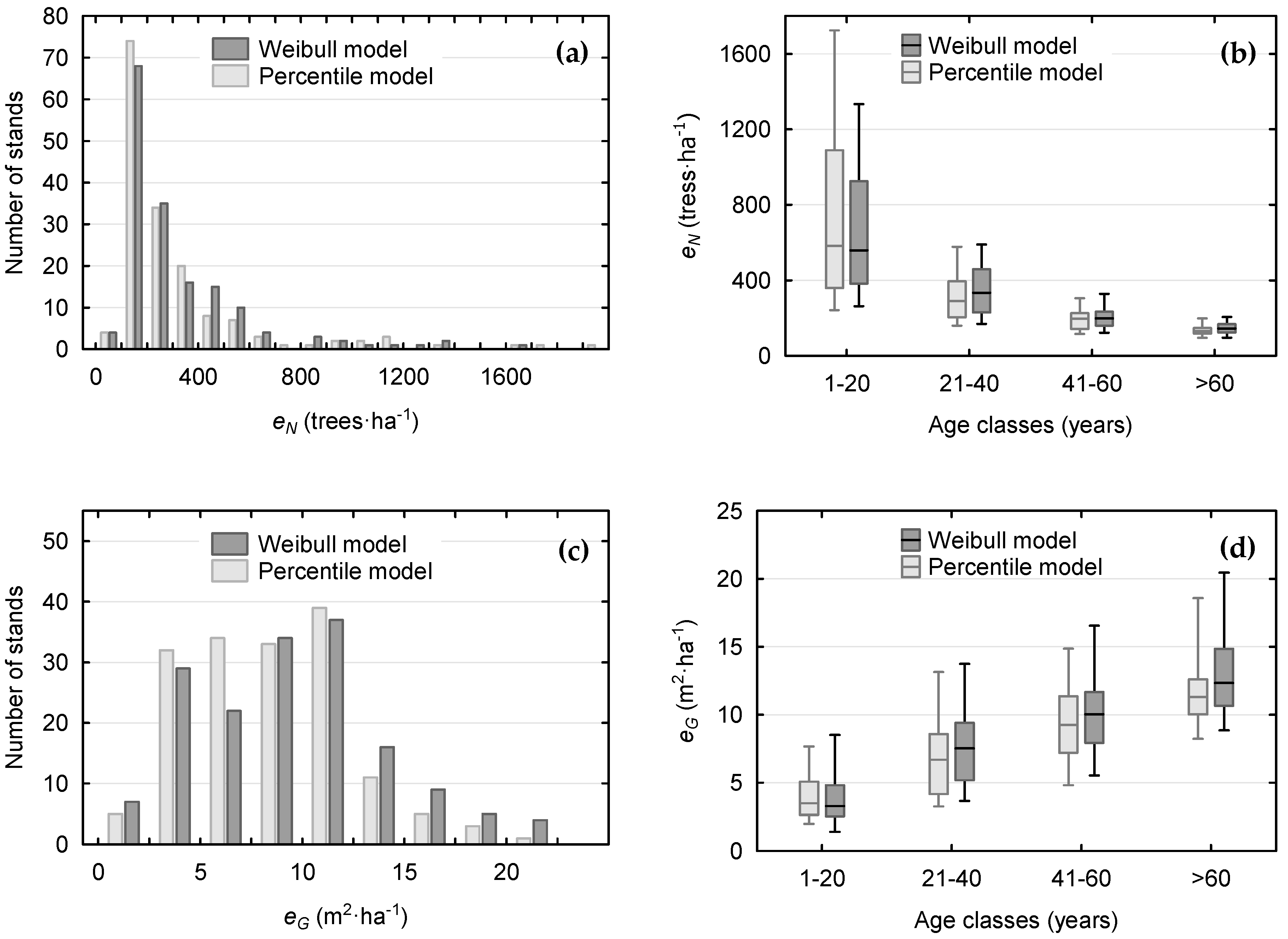
| Statistics | Stand Variable | Tree Variable | ||||||||
|---|---|---|---|---|---|---|---|---|---|---|
| QMD | Age | SD | SDI | HL | SI | BA | DBH | TH | BA | |
| Mean | 21.99 | 44 | 1020 | 528 | 20.49 | 32.4 | 25.21 | 20.3 | 18.9 | 0.04120 |
| StDev | 9.44 | 23 | 885 | 129 | 6.37 | 2.4 | 9.11 | 10.6 | 6.8 | 0.03951 |
| Min. | 4.47 | 6 | 223 | 212 | 6.28 | 26.5 | 5.48 | 1.0 | 2.8 | 0.00008 |
| Max. | 42.95 | 89 | 4360 | 873 | 32.75 | 40.2 | 49.79 | 67.0 | 36.6 | 0.35257 |
| Percentiles | Parameters a0–100 | Parameters b0–100 | R2adj | MSE |
|---|---|---|---|---|
| P0 = a0 + b0 QMD | 0.000 | 0.534 *** | 0.850 | 4.70 |
| P5 = a5 + b5 QMD | −0.663 *** | 0.690 *** | 0.949 | 2.34 |
| P15 = a15 + b15 QMD | −1.039 *** | 0.810 *** | 0.985 | 0.89 |
| P25 = a25 + b25 QMD | −0.929 *** | 0.872 *** | 0.992 | 0.56 |
| P35 = a35 + b35 QMD | −0.714 *** | 0.918 *** | 0.996 | 0.32 |
| P45 = a45 + b45 QMD | −0.451 *** | 0.958 *** | 0.997 | 0.21 |
| P55 = a55 + b55 QMD | −0.155 * | 0.996 *** | 0.998 | 0.15 |
| P65 = a65 + b65 QMD | 0.000 | 1.048 *** | 0.998 | 0.17 |
| P75 = a75 + b75 QMD | 0.284 *** | 1.101 *** | 0.998 | 0.23 |
| P85 = a85 + b85 QMD | 0.681 *** | 1.164 *** | 0.996 | 0.53 |
| P95 = a95 + b95 QMD | 1.186 *** | 1.280 *** | 0.988 | 1.76 |
| P100 = a100 + b100 QMD | 2.574 *** | 1.468 *** | 0.934 | 13.27 |
| Distribution Models | Age Classes of Stands | Dn Statistic | ME | RMSE | |||
|---|---|---|---|---|---|---|---|
| Mean | SD | Mean | SD | Mean | SD | ||
| Weibull | 1–20 years | 0.0977 | 0.0308 | −0.0147 | 0.0175 | 0.0505 | 0.0180 |
| 21–40 years | 0.0937 | 0.0299 | −0.0248 | 0.0162 | 0.0491 | 0.0181 | |
| 41–60 years | 0.0881 | 0.0240 | −0.0206 | 0.0099 | 0.0444 | 0.0133 | |
| >60 years | 0.0900 | 0.0277 | −0.0209 | 0.0125 | 0.0456 | 0.0163 | |
| All stands | 0.0919 | 0.0279 | −0.0207 | 0.0142 | 0.0471 | 0.0164 | |
| Percentile | 1–20 years | 0.0978 | 0.0368 | −0.0018 | 0.0214 | 0.0473 | 0.0209 |
| 21–40 years | 0.0785 | 0.0259 | −0.0122 | 0.0188 | 0.0384 | 0.0151 | |
| 41–60 years | 0.0726 | 0.0282 | −0.0063 | 0.0125 | 0.0331 | 0.0143 | |
| >60 years | 0.0717 | 0.0316 | −0.0051 | 0.0155 | 0.0336 | 0.0177 | |
| All stands | 0.0786 | 0.0315 | −0.0067 | 0.0171 | 0.0372 | 0.0175 | |
| Age Classes of Stands | Dn Statistic | ME | RMSE | |||
|---|---|---|---|---|---|---|
| Z Statistic | p-Value | Z Statistic | p-Value | Z Statistic | p-Value | |
| 1–20 years | 0.257 | 0.7971 | 4.741 | 0.0000 | 1.512 | 0.1310 |
| 21–40 years | 4.130 | 0.0000 | 5.711 | 0.0000 | 5.204 | 0.0000 |
| 41–60 years | 4.622 | 0.0000 | 5.841 | 0.0000 | 5.401 | 0.0000 |
| >60 years | 4.656 | 0.0000 | 5.841 | 0.0000 | 5.108 | 0.0000 |
| All stands | 7.097 | 0.0000 | 11.070 | 0.0000 | 8.936 | 0.0000 |
| Distribution Models | Age Classes of Stands | eN | eG | ||
|---|---|---|---|---|---|
| Mean | SD | Mean | SD | ||
| Weibull | 1–20 years | 675.7 | 378.6 | 4.10 | 2.17 |
| 21–40 years | 352.3 | 144.8 | 7.74 | 3.72 | |
| 41–60 years | 207.4 | 70.3 | 10.24 | 3.67 | |
| >60 years | 146.5 | 34.6 | 13.04 | 3.42 | |
| All stands | 315.0 | 261.4 | 9.22 | 4.58 | |
| Percentile | 1–20 years | 749.1 | 483.7 | 3.92 | 1.59 |
| 21–40 years | 322.2 | 132.5 | 6.86 | 3.08 | |
| 41–60 years | 194.3 | 66.0 | 9.50 | 3.55 | |
| >60 years | 136.0 | 29.6 | 11.74 | 2.91 | |
| All stands | 314.0 | 309.4 | 8.39 | 4.05 | |
| Age Classes of Stands | eN | eG | ||
|---|---|---|---|---|
| Z Statistic | p-Value | Z Statistic | p-Value | |
| 1–20 years | 1.100 | 0.2712 | 0.566 | 0.5717 |
| 21–40 years | 3.345 | 0.0008 | 4.371 | 0.0000 |
| 41–60 years | 3.347 | 0.0008 | 3.979 | 0.0001 |
| >60 years | 4.306 | 0.0000 | 5.017 | 0.0000 |
| All stands | 4.499 | 0.0000 | 7.557 | 0.0000 |
© 2019 by the authors. Licensee MDPI, Basel, Switzerland. This article is an open access article distributed under the terms and conditions of the Creative Commons Attribution (CC BY) license (http://creativecommons.org/licenses/by/4.0/).
Share and Cite
Pogoda, P.; Ochał, W.; Orzeł, S. Modeling Diameter Distribution of Black Alder (Alnus glutinosa (L.) Gaertn.) Stands in Poland. Forests 2019, 10, 412. https://doi.org/10.3390/f10050412
Pogoda P, Ochał W, Orzeł S. Modeling Diameter Distribution of Black Alder (Alnus glutinosa (L.) Gaertn.) Stands in Poland. Forests. 2019; 10(5):412. https://doi.org/10.3390/f10050412
Chicago/Turabian StylePogoda, Piotr, Wojciech Ochał, and Stanisław Orzeł. 2019. "Modeling Diameter Distribution of Black Alder (Alnus glutinosa (L.) Gaertn.) Stands in Poland" Forests 10, no. 5: 412. https://doi.org/10.3390/f10050412
APA StylePogoda, P., Ochał, W., & Orzeł, S. (2019). Modeling Diameter Distribution of Black Alder (Alnus glutinosa (L.) Gaertn.) Stands in Poland. Forests, 10(5), 412. https://doi.org/10.3390/f10050412





